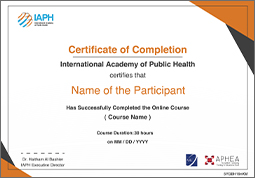Noncommunicable Disease Surveillance
Description
Public health surveillance is "the ongoing systematic collection, analysis, and interpretation of health-related data essential to planning, implementation, and evaluation of public health practice". Public health surveillance is the foundation for evidence informed and effective public health interventions. Surveillance is needed to understand and to monitor the epidemiology of health-related events in order to set priorities and formulate strategies for appropriate public health actions. Surveillance system serves as a tool to document impact of health interventions or to monitor progress towards specified public health goals.
This course provides an overview of public health and non-communicable diseases surveillance systems and methods. It includes an overview of non-communicable diseases surveillance, considerations in planning non-communicable diseases surveillance, sources and collection of data, analysis and interpretation of surveillance data, communication of surveillance data, technology of public health surveillance systems, evaluation of non-communicable diseases surveillance activities, ethical and legal issues in surveillance, local issues in surveillance, surveillance issues in developing countries, and future considerations.
Learning Outcomes
- Understand the structure and flow of data through a non-communicable diseases surveillance system
- Select and explain the source of data to use and identify the strengths and limitations of surveillance data sources
- Identify possible sources of selection bias and information bias for non-communicable diseases surveillance systems
- Analyze and interpret surveillance data, including trends and patterns
- Plan for evaluating non-communicable diseases surveillance systems
- Follow the CDC framework and complete the six steps to evaluating non-communicable diseases surveillance systems
- Uses of Public Health Surveillance Systems
- NCDs Surveillance Systems and Indicators
- NCDs Surveillance As a Function of Monitoring and Evaluation
- Analysis and interpretation of Surveillance Data
- CDC Framework To Evaluate a Public Health Program
- WHO STEP Wise Ppproach to Risk Factor Surveillance (STEPS)


Certificate
